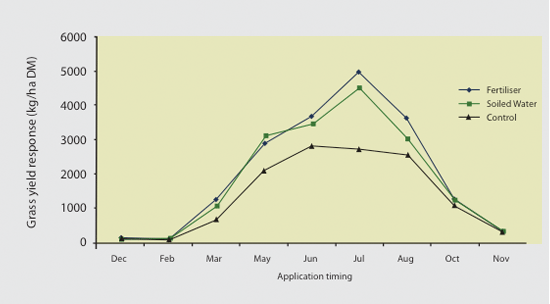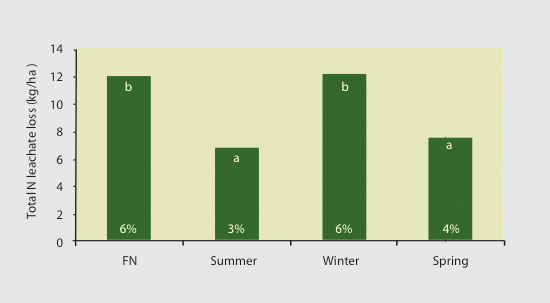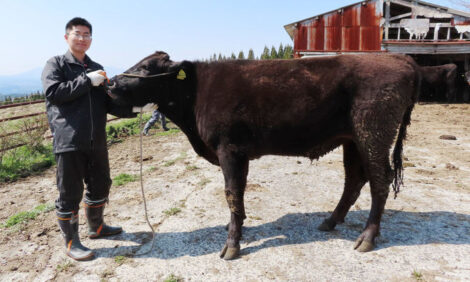



Soiled Water - A Valuable Resource
Researchers at Teagasc Moorepark , in Ireland, have found that dairy soiled water/dilute slurry is a valuable nutrient source that can help increase farm profitability and minimise environmental impacts when managed correctly. Dairy soiled water/dilute slurry (hereafter referred to as soiled water) is a farmyard effluent, produced through washing down milking parlours and holding areas, that contains parlour washings, spilt milk, urine and faeces. Soiled water contains nutrients (0.6kg/m3nitrogen [N], 0.08kg/m3phosphorous [P] and 0.6kg/m3potassium [K]) and can be used as an organic fertiliser to replace some of the mineral fertiliser used on farm, leading to cost savings for farmers and reduced risks of nutrient losses to the environment – a win-win scenario.
Currently, most farmers apply soiled water to grassland without accounting for its nutrient content. Best management strategies are needed, and research undertaken at Teagasc Animal & Grassland Research and Innovation Centre, Moorepark, in collaboration with University College Dublin (UCD) and the National University of Ireland, Galway (NUIG), investigated two such strategies. The first was application to grassland as an organic fertiliser. The second was treatment with a woodchip filter to remove organic matter and nutrients, followed by re-use of water to wash down yards. The focus of both strategies is to recycle nutrients and/or water as efficiently as possible, while minimising environmental losses.
The fertiliser potential of soiled water was assessed in a field plot experiment on two contrasting grassland soils; a free-draining acid brown earth and a poorly drained Gleysol. Soiled water was applied at three rates (zero, 15, 22, 30kgN/ha) every six weeks throughout the year to assess the optimal rate and timing. Soiled water was applied using a watering can, replicating application with a splash-plate, which is the most common application method. Calcium ammonium nitrate (CAN) was applied at the same rates and timings to allow calculation of the N fertiliser replacement value (NFRV) of soiled water (grass growth response to soiled water as a proportion of the response to CAN).
The best yield response to both soiled water and fertiliser N occurred from May to August – the time of peak grass growth potential and N requirement. To maximise uptake and yield response to N in soiled water, it should be applied during this period (Figure 1). On average, soiled water applied from February to September had an NFRV of 80 per cent. High NFRVs were observed on both soil types, indicating a high NFRV across a range of soils. High NFRV was also observed through the summer and autumn. In contrast, NFRVs of only 15-50 per cent have typically been found for slurry, decreasing through the growing season.
Soiled water is more dilute (lower dry matter content) and infiltrates better into the soil, reducing N losses as ammonia emitted to the air and ensuring that N is delivered effectively, and more evenly, to the grass roots. Potential ammonia losses are typically highest in summer and the slow infiltration of more concentrated slurry exposes it to greater losses. Roughly two-thirds of the N in soiled water is organic and not immediately plant available. It was surprising, then, to find such high NFRVs. This may be because soiled water spreads N more evenly to a larger area of the sward, improving N uptake and yield response, compared to fertiliser pellets, which concentrate N in the area around the fertiliser pellet.
Soiled water application may also stimulate release of additional plant-available soil N. Yields increased steadily with increasing soiled water application rate up to 22kg N/ha and then levelled out, suggesting that around 20kg N/ha (around 35,000l/ha) may be an optimal application rate. These results suggest that soiled water applied at 22kg N/ha could replace 17kg N/ha of CAN while maintaining the same grass production. A dairy farm of 100 cows produces around 600kg of N in soiled water annually. This could replace 480kg of fertiliser N, 570kg of K and 80kg of P (assuming 100 per cent availability of K and P). Assuming CAN at €330/tonne, muriate of potash (50 per cent) at €450/tonne and superphosphate (16 per cent) at €425/tonne gives savings of €575/year in N, €513 in K and €212 in P – a significant potential total cost saving of€1,300/year to the farmer.
Figure 1: Grass dry matter yield (eight weeks’ growth) for plots receiving soiled water or fertiliser (average of 15, 22 and 30kg N/ha application rates), applied at six-week intervals over a year.

The risk of nutrient loss to the environment from soiled water applied to grassland was investigated using lysimeters with the same two soils used in the plot experiment. Intact soil cores (30cm diameter by 70cm depth) were extracted and installed as lysimeters. There were four treatments; a control receiving CAN only, and soiled water substituted for CAN at the maximum legal rate (50,000l/ha every six weeks) over three time periods (May to August, September to December, January to April). All lysimeters received a total of 198kg N/ha/year. There were four replicates of each treatment. Concentrations and total fluxes of nutrients were monitored in leachate and N2O emissions were monitored using the static chamber method.
Leachate N loss for the control (12kg/ha) was higher than for treatments receiving soiled water in May to August (6.8kg/ha) and January to April (7.5kg/ha), but not different from those receiving it in September to December (12.2kg/ha) (Figure 2). Similarly, annual N2O-N emissions were lower for treatments receiving soiled water in May to August (4kg/ha) and January to April (3.9kg/ha) than those receiving it in September to December (8kg/ha) or the control (6.4kg/ha). Therefore, substituting soiled water for fertiliser N during the growing season may decrease both nitrate leaching and N2O emissions, and losses can be minimised by application during the growing season. Leachate N loss from the well-drained acid brown earth (14.9kg/ha) was higher than from the poorly drained Gleysol (4.4kg/ha) but, despite the contrasting soil type and drainage conditions, N2O emission was not significantly different.
Laboratory-scale woodchip filters achieved substantial removal of chemical oxygen demand (COD) (93 per cent) and TN (91 per cent) from soiled water. Therefore, three farm-scale pilotwoodchip filters (10 x 10m in area and 1m deep) were constructed at Moorepark to treat soiled water from 300 dairy cows over a year. A network of pipes ensured an even distribution over the surface of the filters. Each filter was loaded with 3,000l/day. Average influent concentrations of COD and TN were 5,750mg/l and 357mg/l, respectively, and decreases of 66 and 57 per cent were achieved. Effluent concentrations remained relatively stable over the study period. Sand filters were investigated as a secondary treatment to further clean the water for re-use. Three replicate single-layer and stratified filters were loaded at 20l/m2/day with woodchip filter effluent for 82 days. Average influent COD and TN concentrations of 1,991mg/l and 163mg/l, respectively, were decreased by 39 and 36 per cent for the single- layer filters, and 56 and 57 per cent for the stratified filters, respectively. Therefore, treatment of soiled water with a woodchip filter followed by a sand filter shows potential as a low-cost, minimal maintenance recycling system to allow re-use of water to wash down yards, decreasing water usage and generation of soiled water on farm. Eventually, filtered soiled water and spent woodchips could be land-applied, supplying nutrients and organic matter to enhance soil fertility.
Figure 2: Annual total N lost in leachate from lysimeters receiving fertiliser N only (FN) and soiled water substituted for fertiliser N at different times of the year. All lysimeters received 198kg N/ha/yr in total. Columns with different letters are significantly different. N loss as a percent of total N applied is also shown.

Improved management of soiled water/dilute slurry through application at appropriate times and rates and/or treatment and re-use can help to increase farm profitability and minimise environmental impacts – a win-win scenario.
December 2011

